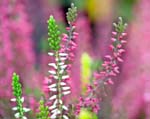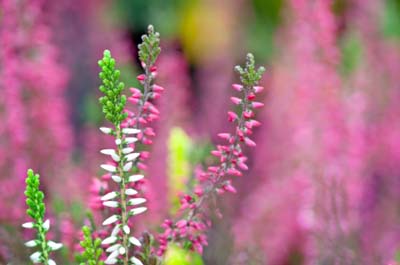Wild about heather
Heathers can look pretty if planted properly, says Tom Coward


At Gravetye, we're lucky being so close to the Ashdown Forest, home of Winnie the Pooh and one of the last great lowland heaths remaining in England. It's a beautiful landscape, especially at summer's end, when the ling heather, Calluna vulgaris, is flowering with carpets of purple into the horizon. In the wild garden at Gravetye, this plant is dotted in clumps among naturalised plantings and catches some of the atmosphere of the forest.
Heather gardens are often thought of as monocultures of multi-coloured carpets, studded with dwarf conifers. But when these plants are used in clusters among grasses, azaleas, bulbs, perennials and self-sowers, they can take on a very different feel.
We have six species of heathers native to the UK, and by far the most common and versatile is ling, which occupies lowland heath and vast areas of moorland, from Cornwall to the far north of Scotland. In our gardens, it has been hybridised into hundreds of different forms and colours, both in foliage and flower.
* Follow Country Life magazine on Twitter
We're currently establishing some new clumps of ling and, so that the plants fit into the wild garden, we have restricted our selection of cultivars to large, vigorous forms, which don't have brightly coloured foliage. After some consultation with a few nursery growers and some visits to the heather garden at RHS Wisley, we've decided on just three varieties: H. E. Beale for a pink, Arabella is deep red, and Mair's Variety is white.
We first prepare the bed by weeding thoroughly and digging in a low-pH compost to improve the structure of our thick clay soil. Then, the lings are planted in clumps, about 18in apart, so that they will soon grow into each other, to make that characteristic soft, evergreen mound. We don't mix the colours and keep the mounds quite separate, allowing us to interplant with various other ingredients.

The architectural structure of Euphorbia characias contrasts well with the mounds of heathers, while grasses, such as Stipa tenuissima, add extra texture. Bulbs, such as species tulips, Scilla and Camassia can then be run through this planting to add some excitement in the spring and the use of azaleas should round off the planting with some height, structure and early-summer colour.
Sign up for the Country Life Newsletter
Exquisite houses, the beauty of Nature, and how to get the most from your life, straight to your inbox.
Self-sowers can also be used to soften this planting and our native Echium vulgaris and ox-eye daisies work especially well together, surfing the line between being desirable plant and weed.
A more extensive way of using heathers in the wild garden is to establish clumps among trees and long grass. After a few years of care, to allow the lings to establish, the grass can just be allowed to grow among them, giving a very natural appearance.
Lings are tough, vigorous, resilient little shrubs, but they do insist on having an acid soil. There are a few heathers, however, that will grow in most soil types, acid or alkaline, full sun or partial shade, such as Erica x darleyensis, Erica tetralix and winter heather, Erica carnea. Originating in the Alps, this little plant is so tough that it will grow almost anywhere, as long as it has plenty of sun and drainage.
Flowering throughout late winter and early spring, its compact cushions are beautiful in frost, snow and sun. At Gravetye, it works especially well on the top of a wall, alongside geraniums and sedum with common vetch, Vicia sativa, scrambling through. Some people call it a weed, but I love its delicate blue flowers in the summer and the contrast of its petite, pinnate foliage against the spikiness of the heather is beautiful.
* Give Country Life for Christmas and save up to 40% on a subscription
Globally, heathers are a huge group of plants ranging from tiny, delicate cushions to small trees. They're usually tough enough to require little care once established, only needing a trim below the flower spikes after flowering; this is important in the early years to produce tight, compact plants with more flowers. There are a number of very good heather nurseries in the UK and I get mine from John Hall in Hampshire (01428 715505; www.johnhallplants.com), who has an excellent range and can give very good advice.
Four plants for £25 Get four mixed hardy plants, selected for you from the Country Life nursery and delivered to your door, for £25. Visit www.countrylife.co.uk/nursery for your special offer.
Country Life is unlike any other magazine: the only glossy weekly on the newsstand and the only magazine that has been guest-edited by HRH The King not once, but twice. It is a celebration of modern rural life and all its diverse joys and pleasures — that was first published in Queen Victoria's Diamond Jubilee year. Our eclectic mixture of witty and informative content — from the most up-to-date property news and commentary and a coveted glimpse inside some of the UK's best houses and gardens, to gardening, the arts and interior design, written by experts in their field — still cannot be found in print or online, anywhere else.
-
 The King's favourite tea, conclave and spring flowers: Country Life Quiz of the Day, April 22, 2025
The King's favourite tea, conclave and spring flowers: Country Life Quiz of the Day, April 22, 2025Tuesday's Quiz of the Day blows smoke, tells the time and more.
By Toby Keel
-
 London is the place for me* (*the discerning property buyer)
London is the place for me* (*the discerning property buyer)With more buyers looking at London than anywhere else, is the 'race for space' finally over?
By Annabel Dixon